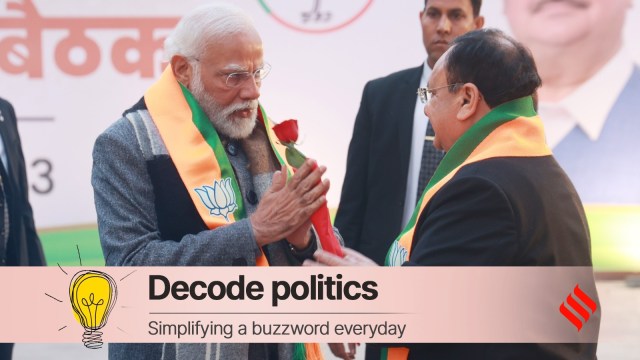Decode Politics: Why ‘Modi guarantees’ will be BJP’s key poll pitch in 2024
At the meeting of the BJP’s national office-bearers that concluded on Saturday, the thrust was on making Modi guarantees central to the party’s welfare narrative for the campaign.
 Prime Minister Narendra Modi is welcomed by BJP national president JP Nadda upon his arrival to attend BJP's national office-bearers meeting at the party headquarters, in New Delhi, Friday, Dec. 22, 2023 (Express Photo By Amit Mehra)
Prime Minister Narendra Modi is welcomed by BJP national president JP Nadda upon his arrival to attend BJP's national office-bearers meeting at the party headquarters, in New Delhi, Friday, Dec. 22, 2023 (Express Photo By Amit Mehra)The BJP over the last two days held a marathon meeting of its national office-bearers with an eye on the Lok Sabha elections and to assess the recent Assembly election results. While Prime Minister Narendra Modi was at the meeting till late on Friday, Union Home Minister Amit Shah was present till the meeting concluded on Saturday.
At the meeting, the thrust was on making “Modi guarantees” central to the party’s welfare narrative when campaigning begins for the parliamentary polls and the party seeks votes based on Modi’s popularity to return to power for a third straight term.
What are Modi guarantees?
These promises were the party’s central pitch during the recent Assembly elections, billed as the PM’s pledge to voters. In its manifesto for Chhattisgarh, for example, the party highlighted the top 20 “Modi guarantees” such as Rs 12,000 annually for married women, filling government job vacancies, Awas Yojana (housing scheme) benefits for the poor, and free health service up to Rs 10 lakh and 500 more centres for subsidised medicines. On the campaign trail in Chhattisgarh and Madhya Pradesh in November, Modi announced the extension of the Pradhan Mantri Garib Kalyan Anna Yojana (PMGKAY) free ration scheme for another five years saying it would benefit 80 crore poor people in the country. “Modi ki guarantee matlab har guarantee poori hone ki guarantee (Modi’s guarantee is a guarantee that every guarantee shall be fulfilled),” the PM said at his rallies in all the states.
Following the victories in Madhya Pradesh, Rajasthan, and Chhattisgarh, the BJP attributed the successes to the traction the Modi guarantees got with voters. Last week, flagging off the government’s Viksit Bharat Sankalp Yatra — being organised to spread awareness about the government’s welfare schemes — in the five states where the elections were held, the PM said, “Jahan par doosron se ummeed kam ho jati hai, wahi se Modi ki guarantees shuru ho jati hai. Aur isliye hi Modi ki guarantee wali gaadi ki dhum machi hui hai (Where hope from others ends, Modi’s guarantees begin from there. And that is why Modi’s guarantees are popular).”
What is the BJP’s aim?
With this, the BJP will find it easy to counter the guarantee politics of the Opposition parties, especially the Congress that won the Himachal Pradesh election last year and in Karnataka and Telangana this year on the back of a raft of promises it made to the electorate, trumping the BJP and other parties on the welfare narrative battle. The BJP had been searching for an answer to the Congress’s hyperlocal campaign that worked in Karnataka, and with the Modi guarantees it seems to have found a winning formula — welfare initiatives coupled with the PM’s mass appeal.
In addition, anti-corruption is among the BJP’s major planks — it successfully targeted the Congress over it in the three Hindi-speaking states in the recent elections — and the emphasis on it is likely to continue in conjunction with the emphasis on welfare politics till the Lok Sabha elections.
Who are labharthis and why are they important to BJP?
The BJP has created a new base of labharthis, or welfare beneficiaries, on whose support it has been dependent in elections since around 2017-’18. The BJP claims that the ever-growing loyal support base of labharathis trumps caste barriers and has propelled the party to victories in the 2019 Lok Sabha elections and crucial state polls. Before the 2019 elections, the party put the number of beneficiaries at 25 crore. The BJP received 22.9 core votes in that election, emphasising why this category of voters is important to it.
Then there is the EWS quota too. With the Constitution (103rd) Amendment, which received the Supreme Court’s approval last year, the government allowed a 10% quota for the poorest of the poor among upper castes. The BJP with this move sought to get around caste-based reservations by pushing welfarism among the poor who are outside the purview of Mandal politics. Given how populist politics reaps dividends, the party has likely realised that painting sops as “revdi” may not give it as much electoral returns as framing the narrative in terms of a battle between the Modi guarantees and the Opposition’s promises.





- 01
- 02
- 03
- 04
- 05


























